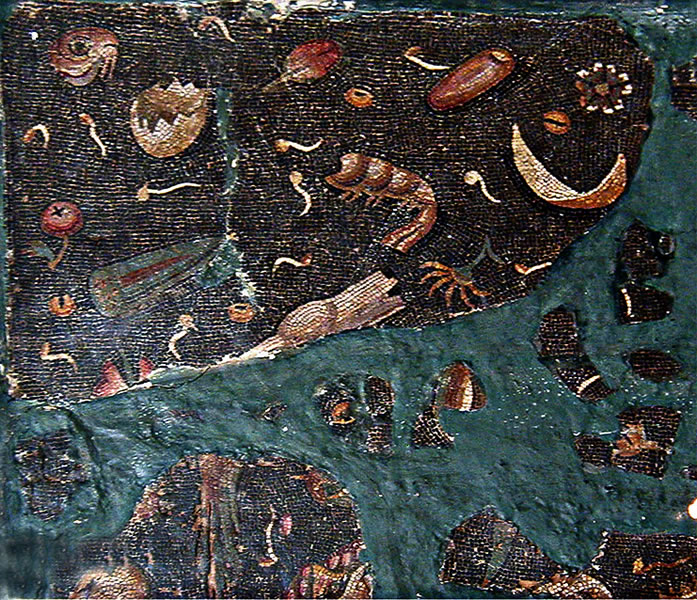Asaratos Oikos

From Pliny the Elder we know the name of the artist to whom we owe the invention of two themes that were a model for the artists of Greek, and later Roman, mosaic art: Sosos of Pergamum lived in the second century. B.C.
When Sosos was commissioned to create a decoration for the triclinium of the palace of Pergamum, he chose two themes that then became iconographic themes for the art of the ancient world: the doves drinking but , above all, the un-swept dining room or asaratos oikos .
This is how Pliny (Naturalis Historia, 36, 184) describes these wonders:
Celeberrimus fuit in hoc genere Sosos qui Pergami stravit quem vocant asaroton oecon,quoniam purgamenta cenae in pavimentis quaeque everri solent velut relicta fecerat parvis e tessellis tinctisque in varios colores. Mirabilis ibi columba bibens et aqua mumbra capitis infuscans. Apricantur aliae scabentes sese in canthari labro
Sosos invented these two decorations where in the first, with small colored pieces, the remains of the banquet were represented on the floor and which was therefore called the "unswept room" and in the second a couple of doves drinking ; these are two themes that represent the passage that took place in Hellenistic art in the second century BC. when representations of daily life, of reality in its continuous change, also entered the themes of art.
Theme of Asaratos Oikos was used in tricliniums where it was customary for diners to throw leftover food on the ground and more numerous and different they were, better they represented the opulence of the guest.Some scholars argue that the mosaic designs were intended to mask the dirt on the floor during the banquet, while others also connect symbolic meanings such as keeping the evil deities away.
Surely King Attalus III in the dining room of Pergamon Palace hosted Scipio Aemilianus who then had the opportunity to see the work of Sosos. In 133 BC Attalus died and bequeathed to Rome all his possessions and the treasure of his city, Pergamon, which in fact placed under the protection of Rome. Artists and artisans then moved to Rome and brought iconographic models of their shops there, including the theme of the "unswept room".
The banquet was very important in Rome where it was not only a time of aggregation but, especially after the end of the republic, it also became a form of ostentation of wealth and munificentia; in the triclinium, furnished with bronze beds, the banquets included a considerable number of courses and therefore also leftovers that the diners simply threw on the ground.
The iconography of the Asaratos Oikos had great fortune in Rome where not less than in Greece, in both of them it had its function not only for decorative flooring but also for confusing the leftovers "picti" with the real ones during banquets. Still in the 1st century AD Horace, In his Sermones, reproaches the rich for spending on triclinium fabrics and coverings, but not on brooms, rags and sawdust ...
Sign up and read the rest of the article!
by M.L. ©ALL RIGHTS RESERVED (Ed 1.0 - 03/09/2020)






